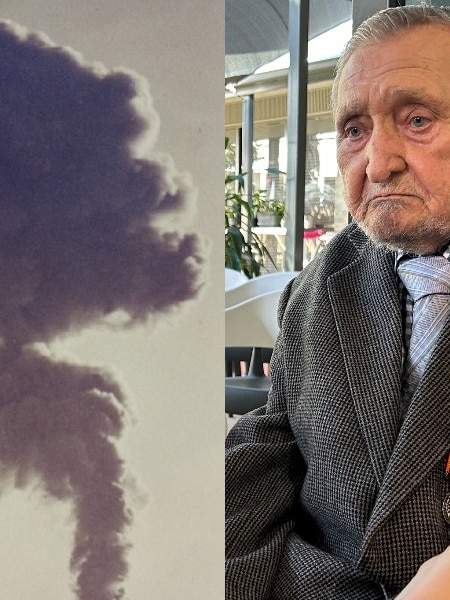Sam Darke is thought to be the last person alive to have stood within 3 miles of a British nuclear detonation in 1953.
The 91-year-old has been awarded a British Nuclear Test Medal in recognition of his role in the Totem 1 detonation at Emu Field in South Australia on October 15 of that year.
Mr Darke was just 19 when he enlisted in the Royal Australian Air Force and was ordered to participate in the secret mission.
He said he had no idea what to expect.
“We were shocked alright,” Mr Darke said.
He said the Australian servicemen were positioned closest to the detonation site and were not given any protective clothing, unlike the British scientists further away who were clad in full-body “goon” suits.
They were told to cover their eyes.
Mr Darke recalls everything flashing white, and feeling the heat.
It took 17 seconds for the impact to the reach them, knocking many off their feet.
“The blast hit us. We fell arse over head,” Mr Darke said.
“Oh, we were guinea pigs alright.”
Mr Darke received the medal surrounded by family, including his wife Betty, at his Grafton nursing home in northern New South Wales.
His son, Dennis Darke, approached the British government 18 months ago to get the recognition for his father.
“It took over 70 years for the British government to recognise not only the Australian servicemen and women, but all the people that were involved,” Mr Darke said.
“That’s way too long.”
Long-term fallout
James Cook University academic Elizabeth Tynan is the author of The Secret of Emu Field, a book that documents the testing program and the impacts on service people from Australia, the UK, Canada, and New Zealand, as well as local communities.
Professor Tynan said there was still a great deal of anger within the nuclear veterans’ community that they were kept in the dark.
“The broader Australian population was oblivious to these tests and yet the fallout covered the entire continent,” she said.
“The secrecy hid a great many sins that were committed as part of this test series and there’s still active actions underway today to get some redress.”
Professor Tynan said the tests were hastily put together, with both terrain and meteorology poorly understood and no consideration given to the local Anangu people.
She said fallout known as “black mist” broke away from the main atomic cloud and rolled over the landscape towards Indigenous communities nearly 200 kilometres from the test site.
“The black mist did untold damage to communities in that area, caused sickness and injury and death,” Professor Tynan said.
“It is still not really known exactly what the black mist was and at the time of the test it wasn’t investigated.”
Get our local newsletter, delivered free each Friday
Posted , updated




